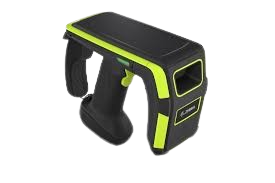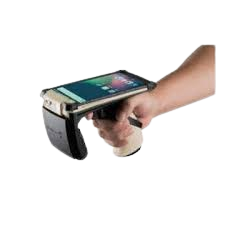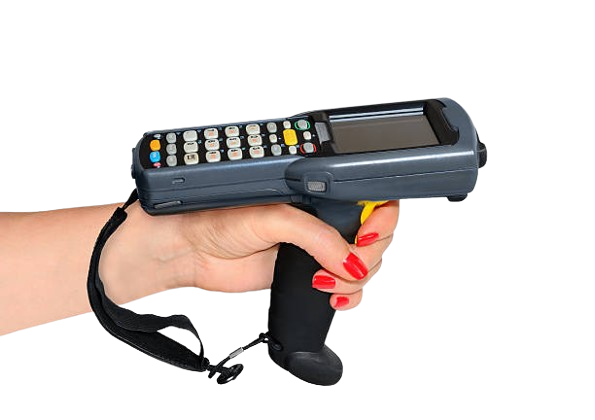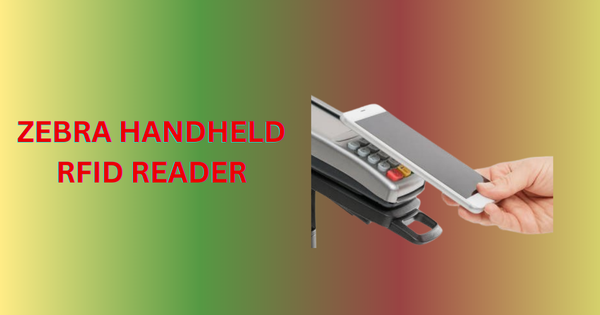Zebra handheld rfid reader
Zebra handheld RFID readers are an excellent way to read tags while on the go since they give you the mobility you need for many kinds of applications.
Table of Contents
ToggleZebra Handheld RFID readers
UHF handheld RFID readers are an excellent choice for reading RFID tags on the go, providing necessary mobility. For convenience and instant data exchange, these portable RFID readers come with built-in antennas and a display. They are perfect for tag programming and are commonly used for inventory taking. With 1,300+ tag scans per second (up to 30% faster than the next top competitor), a 20+ foot read range, and a very precise item-finder mode, the Zebra RFD40 UHF Handheld RFID Reader performs better than its competitors. It can run for hours on end thanks to its 7000mAh battery and rapid release feature, which can be used without taking the mobile device out. Associates can easily access barcode scanning, RFID reading, and a third function that can be programmed with the tri-function trigger, such as the enter key or push-to-talk. Zebra’s present mobile computers, as well as any future models, can be fully supported by the RFD40 sled. Without sending devices to IT for retrofitting, associates can swiftly replace the adaptor while preserving compatibility thanks to the tool-free, simple-to-change sled adaptors.
What is a Zebra handheld RFID reader?
Zebra handheld RFID readers are a great option for reading tags on the go, providing the necessary mobility for various applications. With a few exceptions, these readers usually have integrated antennae and displays enabling simple operation and instantaneous data engagement. In addition to being great for programming tags, handhelds are frequently used for inventory taking. A Zebra handheld RFID reader is a portable gadget that tracks and scans tagged objects using radio frequency identification (RFID) technology. RFID readers don’t need a direct line of sight to read many tags at once, unlike conventional barcode scanners.
Key Features of Zebra RFID Readers:
Accurate and Quick Scanning: Reads several RFID tags simultaneously.
Sturdy Design: Made to resist challenging conditions.
Long Battery Life: Guarantees a longer period of operation.
Fast Connectivity: adaptable to a wide range of commercial software and apps.
User-friendly Interface: Requires little training to use.
How Does a Zebra Handheld RFID Reader Work?
Radio waves are used by the Zebra Handheld RFID Reader to connect to RFID tags. The procedure is as follows: Three parts make up every RFID system: a transceiver, a transponder, and a scanning antenna. They are called RFID readers or interrogators when the transceiver and scanning antenna are coupled. RFID readers come in two varieties: stationary readers and portable readers. The RFID reader is a network-enabled gadget that can be fixed or carried about. It transmits impulses that activate the tag via radio waves. When the tag is engaged, it transmits a wave back to the antenna, which converts it into information. The actual RFID tag contains the transponder. The RFID tag’s read range is contingent upon various parameters, such as the tag type, reader type, RFID frequency, and interference from other RFID tags and readers or the surrounding environment. The read range is longer for tags with a more powerful power source.
Tagging Items: An RFID chip with a distinct identifier is attached to every asset or commodity.
Signal Transmission: To identify adjacent RFID tags, the handheld reader sends out a radio signal.
Data Capture: The RFID tag replies by delivering its stored data back to the reader.
Data processing: The reader forwards the gathered information to linked software for tracking or inventory control.
This system improves asset tracking and management efficiency while drastically lowering manual labor.
Types of Zebra Handheld RFID Readers
1. Fixed RFID Readers
Installed in specific locations like entry points or conveyor belts.
Ideal for automated inventory tracking.
2. Handheld RFID Readers
Portable and flexible for various business applications.
Perfect for real-time inventory tracking and asset management
Best Zebra Handheld RFID Models:
Zebra MC3330R: lightweight and high-performance RFID reader.
Zebra MC3390R: Long-range scanning capability.
Zebra RFD40 & RFD90: ultra-rugged design for harsh environments.
Others modals
Zebra RFD8500 RFID Reader
Zebra FX9600 RFID Reader
Zebra FX7500 RFID Reader



Key Features
The MC3390xR has integrated mid-range or long-range 1D/2D barcode scanning, so employees don’t require separate devices to scan barcodes and RFID tags. Select between a mid-range and an extended range scan engine, which can read barcodes up to 70 feet (21.4 meters) away and as close as 3 inches (7.62 cm). Zebra’s unique PRZM Intelligent Imaging technology is available in both options for the first time, capturing 1D and 2D barcodes in any condition. Unmatched computational power—each model comes with a 2.2 GHz octa-core processor, 4 GB of RAM, and 32 GB of flash to handle your most demanding apps and apps of the future.Full shifts are powered by the industry-leading 7000mAh battery.No MC3390xR comes without the new 7000mAh extended capacity battery. More power means fewer battery changes, easier battery management, and a smaller battery pool. And Zebra’s PowerPrecision+ technology gives a full range of measurements that make it easy to identify, remove, and replace aged batteries. Best-in-class RFID read range and accuracy Twenty times farther than the next top competitor, the integrated long-range antenna can read RFID tags more than 60 feet (18.2 meters) away. You can manage your on-the-floor, backroom, and distribution inventory more effectively thanks to the dependable, long-range RFID performance that makes it possible to conduct more frequent and accurate inventory counts.
Benefits of Using Zebra Handheld RFID Readers
Zebra handheld RFID readers offer benefits including real-time inventory visibility, increased accuracy, and enhanced productivity. They streamline operations and eliminate errors by enabling effective product tracking throughout workflows and supply chains. Thanks to RFID tagging, businesses can see what’s on a whole pallet as it enters or exits the dock. This automation enables more visibility and simplicity in inventory management in a shorter time, removing the need for human scanning of every barcode. The software can provide notifications when inventory is low, monitor levels, and automate reorders, resulting in enhanced employee productivity.
Let us go down to understand it point by point.
Benefits of Using Zebra Handheld RFID Readers
1. Enhanced Inventory Arrangement
Count and monitor inventory quickly without requiring human input.
Minimizes the mistakes made by conventional barcode scanning.
2. Enhanced Efficiency of Operations
expedites asset tracking and inventory taking.
Enables workers to concentrate on more strategic duties.
3. Enhanced Data Accuracy
eliminates human mistakes in inventory control.
Gives information on stock levels in real time.
How to Choose the Best Zebra RFID Reader for Your Business
Take into account the requirements of your application, including read range, environment (rugged or not), fixed versus handheld, and whether barcode scanning is also required. Some considerations you should make when doing this are listed below: Operating Frequency According to the broadcast frequency range, there are three different kinds of antennas, as was previously discussed. All kinds of antennas have benefits and drawbacks. For instance, unlike high-frequency antennas, low-frequency antennas are impervious to signal interruptions from metal surfaces. But doing so also slows down their reading speed and restricts their range to a few meters. So, you can choose among these three types of antennas based on the materials, size, and volume of your facility.
Range of Reading
An RFID reader’s range can range from a few inches to 20 meters, and in certain situations, much farther. Therefore, choose which choice is ideal for you based on the size of your property.
Number of Antennas
Typically, integrated RFID scanners only contain one antenna. However, they also have the ability to connect more external antennas if necessary. Integrated readers can only add two more antennae, in contrast to standard readers that can have up to 32.
Utilization
Integrated RFID readers are useful in many different industries because of their aesthetics, ease of use, and ergonomics. When a low read range is required in jewelry stores, they can be utilized inside showcase cabinets. Alternatively, you will require mid-range readers at mall security exit gates. You can choose the best option for you based on how the reader is used in your company.
Conclusion
The Zebra Handheld RFID Reader is a game-changer for businesses seeking efficient inventory management and asset tracking. With its rugged design, extended read range, and seamless connectivity, it enhances accuracy, reduces manual labor, and improves overall operational efficiency. Whether in retail, healthcare, logistics, or manufacturing, Zebra RFID readers provide a reliable solution for streamlining workflows. Investing in Zebra’s advanced RFID technology ensures long-term benefits, cost savings, and a competitive edge in the market. Upgrade to Zebra RFID readers today and experience the future of inventory management.
frequently asked questions
1.How accurate are Zebra RFID readers?
Because of their excellent accuracy rate—typically over 99%—zebra RFID scanners are perfect for inventory tracking.
2. Can Zebra handheld RFID readers scan barcodes?
Yes, some Zebra RFID scanners have two functions: they can scan barcodes.
3. What is the typical range of a Zebra RFID reader?
Model-specific ranges range from a few inches to more than thirty feet.
4. Are Zebra RFID readers waterproof?
Numerous models of Zebra are tough and made to resist collision, water, and dust.
5. How much does a Zebra handheld RFID reader cost?
The normal price range is between $1,000 and $4,000, depending on the model and amenities.


